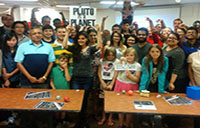

Plutopalooza participants celebrate the arrival of NASA spacecraft New Horizons to the Pluto system. Photograph by Keiron Smith
Close to 100 people from all over Toronto converged at York University to celebrate an historic moment in space exploration when two undergrads organized Plutopalooza.
The event, held July 14, celebrated the arrival of NASA spacecraft New Horizons to the Pluto system and marked the finale of a 9.5-year-long journey. Launched in 2006, New Horizons ventured some 4.8 billion kilometres into the outer reaches of the solar system to unveil the planet’s system, and fits the last missing piece into the puzzle of our solar system.
Undergraduate students Sophia Nasr and Atifa Syed of York U’s Astronomy Club organized Plutopalooza to celebrate the arrival of New Horizons to the Pluto system and our first ever up-close look at the planet.

Team Plutopalooza organizers: Christopher Lansdale, Armita Jalooli, Sophia Nasr, Atifa Syed, Ishfaaq Muhammad Jookhun, Susan Chen and Kevin Nikelski. Photograph by Nikolaos Balaskas
During the event York U astronomy Professor Pat Hall discussed the synchronous orbit of Pluto and Charon, which he called the “double planet”, and space science Professor John Moores shed light on Pluto’s topology and atmosphere.
Live coverage of the mission streamed on NASA TV showed team scientists on tenterhooks as viewers awaited the spacecraft to “phone home” and confirm the mission’s success. At 8:52pm, the signal arrived and the New Horizons team announced “nominal status” of the spacecraft: the flyby, a venture nine years in the making, was safely and successfully complete.
The spacecraft’s flyby marks a giant leap in space exploration and offered our first-ever look into the Kuiper Belt, a distant region in the solar system previously unexplored.
Exploring Kuiper Belt objects like the Pluto system will reveal important details of the solar system’s formation, and help explain the formation of other star systems.
The flyby also marks the last time humankind will ever get their “first look” at other worlds in the solar system.
Global News made an appearance at Plutopalooza, broadcasting a clip of the event on Global’s News Hour Final that night (found here at the 11:40 mark).
As well, seven lucky participants won raffled copies of educational astronomical software donated by Simulation Curriculum Corp, including desktop software Starry Night 7, and mobile app Sky Safari 4.
The Astronomy Club and the York University Observatory received support for the event from the Faculty of Science and Simulation Curriculum Corp.
